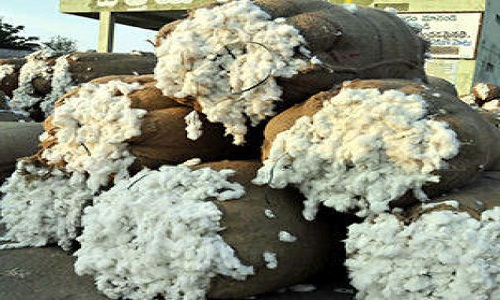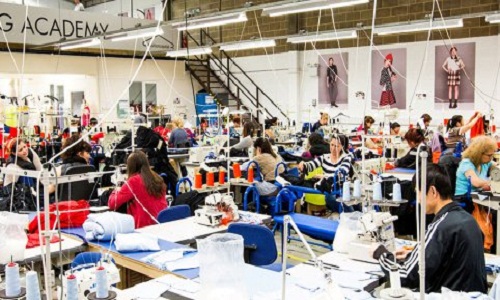FW
Nearly all UK stores of US-based clothing brand American Apparel have shut down. American Apparel filed for Chapter 11 bankruptcy in the US in October 2015. The teen retailer, founded in 1989, made its clothes in Los Angeles and was known for its sexually charged advertising. The hoped-for turnaround of the clothing manufacturer and retail chain—which has long grappled with shrinking sales and an outsize store footprint—did not happen. Plans to improve online selling didn't pay off, and, at a time when shoppers are going online in greater and greater numbers, American Apparel watched its online sales fall.
American Apparel has 110 stores in the US and 83 others around the world including UK, Ireland, Germany, Spain, Canada, Japan and Australia. Canadian manufacturer Gildan Activewear has agreed to buy the brand’s worldwide intellectual property rights. The Canadian clothing company is more interested in buying some of American Apparel’s manufacturing plants in the US. But most production will probably move to Gildan’s manufacturing hubs in Central America and the Caribbean where it’s much lower cost than anywhere in the US.
At least eight US teen retailers have filed for bankruptcy in the past two years as the spending habits of young people shift and they visit malls less often.
Textiles are often regarded as one of Vietnam’s key export sectors with an average annual growth rate of 15 per cent during 2010-2015. However, it is also faced with a slew of challenges of which the most recent challenge stems down to labour in the country no longer being as cheap as it once was.
On the other hand, it is also difficult to raise the textile industry to a higher level due to competitive factors in labour skills, modern technologies and equipment and diversified products. Due to limited resources, most domestic companies choose to gradually invest each year. This situation is in contrast compared to FDI as they represent less than 25 per cent of the nearly 7,000 textile enterprises nationwide but account for 70 per cent of the total export capacity. This shows that the overwhelming advantages of foreign companies over domestic enterprises will only continue to grow if reasonable policies and development direction are not soon formed.
According to the Vietnam Textile and Apparel Association, 2016 was an extremely difficult year for the country's textile industry, with the lowest growth rate since 2008 (the year that Vietnam's garment recorded no export turnover growth due to the global economic crisis) so far. By 2018, Vietnam's garment industry has been forecast to face many challenges, especially in regards to small and medium-sized enterprises facing the risk of closing down due to poor competitiveness and extremely difficult production conditions.
In order to ensure rapid decision-making in key strategic area and synergies of integration, on the occasion of INDIA ITME 2016, the Santex Rimar Group launched Santex Rimar India denoting a direct presence of the Group sales and service in the country to increase accountability and ensure continuous support, improved quality and more efficiency for customers. The company’s products portfolio includes Santex, Sperotto Rimar, Cavitec, Isotex, Solwa and Smit.
Giving details, Santex Rimar Group CEO Stefano Gallucci said that the Indian textile, apparel and technical textile markets are projected to grow at a CAGR respectively of 9 and 8 per cent from 2013 to 2023. In this scenario customers need to have a direct relationship with the company. And that is what the company wants and fulfill all their needs faster and better. The company is recruiting experienced talent that can be new proud Group members looking forward to enhancing customer relations.
The company has already installed more than 4,000 machines all over India and wants to keep growing together with its customers. The Group is a technology partner for knitted, woven fabrics, technical textiles, nonwovens and green solutions. Cavitec and Isotex lead the technical textiles machinery market while Santex and Sperotto Rimar produce machines for textile finishing. On the other hand, Solwa provides eco-friendly machinery for water treatment and food dehydration, agribusiness sector and industrial waste management.
Productivity, quality, reliability and energy saving are key values for Santex Rimar Group: the new sales and service organization in Indiais directly taking care not only of customers’ needs but also of their future developments. Since Research and Development is at the heart of our growth, the Group is also in close contact with different institutes where researchers and students are trained: technical textile technology is taught on Cavitec’s plant in Surat while weaving technology is practiced in Ichalkaranji on SMIT looms. Santex Rimar India facilities are based in Coimbatore and Mumbai.
The Vietnam textile industry which saw export value grow 15 per cent per year in five years from 2010 to 2015 is expected to reach $29 billion this year in terms of export value. While the target in export value was much lower than the figures in reality, the development plan was not suitable with the real development of the industry. Though the textile and garment industry was slated to reach $20 billion in export value in 2015 but the industry has reached an export value of $27.5 billion.
The Vietnam Textile and Apparel Association asked the government and sectors to review its development plan for the garment industry by 2020 in order to support local textile and garment enterprises to take opportunities as well as overcome challenges from free trade agreements.
The Association has said there should be renovation of the development plan for the textile and garment industry by 2020 and towards 2030. This is necessary because the industry expects to enjoy many advantages in development over the next 10 years. The adjustment of the plan should be effective until 2025, and towards 2040.
The association has also suggested building development plans for the industry including industrial zones. Many small textile and garment firms have not been put up in specialized zones for the textile and garment sector that led to difficulties in the management and treatment of waste water. This is related to the industry’s sustainable development and protection of the environment.
"To ensure supplies to the Indian textiles industry, the Cotton Corporation of India (CCI) has resorted to commercial purchase of cotton at market rates from around the country. CCI has issued notices reaching out to buyers informing them that they will shortly commence e-auction of FP bales for the cotton season 2016-17. Buyers who are not yet registered may register themselves with the for participating in e-auction of FP bales."

To ensure supplies to the Indian textiles industry, the Cotton Corporation of India (CCI) has resorted to commercial purchase of cotton at market rates from around the country. CCI has issued notices reaching out to buyers informing them that they will shortly commence e-auction of FP bales for the cotton season 2016-17.
Buyers who are not yet registered may register themselves with the for participating in e-auction of FP bales. M M Chockalingam, CMD (in-charge) said that after a gap of almost four years, the Corporation has made a small beginning and purchased about 1,000 bales of 170 kg each so far at commercial rates from various centres even as cotton trades firm on lower arrivals due to the impact of the currency crunch.

The CCI expects to purchase around 15 lakh bales for the season of 2016-17. The prices of the commodity are ruling between Rs 5 000 and Rs. 5,200 per quintal in various markets while Minimum Support Price (MSP) is at Rs 4,160 per quintal and therefore procurement at MSP seems unlikely, he added.
However, apart from MSP operations, CCI also has to perform commercial operations at times in the interests of the farmers and to keep the market stable. CCI has been purchasing kapas or raw cotton from markets wherever the prices are lower. The commercial purchase of up to 15 lakh bales would be mainly from the West, Central and Southern parts of the country as prices in the Northern markets are being quoted at a higher price. Kapas prices are ruling between R5, 000 to R5, 200 per quintal in various markets. While prices are expected to soften a bit from next month, most experts have ruled out a drastic fall.
Sutlej is one of the largest integrated textile manufacturing companies and is strongly positioned in the production of value added synthetic, natural and blended yarns, spun yarns, processing of fabrics and home textiles. Sutlej has a strong global clientele and exports to more than 60 countries. It exports to: Australia, Argentina, Bangladesh, Bahrain, Belgium, Brazil, Canada, China, Chile, Cuba, Egypt and France. For fiscal 2016 and the half year ended September 30, 2016, total export revenue as a percentage of total revenue was about 26 per cent. The home textile segments contribution of exports to total revenues is more than 35 per cent.
The company will continue to upgrade existing facilities by adding, modernising existing machinery and installing additional latest technology machines across segments. After witnessing sluggish growth during 2008, the home textile segment has shown signs of recovery and registered considerable growth in the last few years. The home textile segment is growing at a CAGR of 3.5 per cent. The US and EU are gradually coming out of the recessionary phase. Apparel and home textile consumption is picking up. Going forward India's share is expected to rise from seven to ten per cent.
To arrest the widening trade deficit as substantial capacity to produce exportable surplus is either fully or partially closed due to high energy cost and other factors, the Pakistan Textile Exporters Association (PTEA) has asked for immediate announcement of textile package as promised by the prime minister earlier.
Talking about export figures, PTEA chairman Ajmal Farooq and vice chairman Muhammad Naeem expressed concern over widening trade deficit and shrinking exports. Quoting figures, they said the country's exports plunged 3.93 per cent to $8.18 billion during July-November this year, which was $334.68 million less than the comparative period of previous year. Compared to this, the import bill increased 8.7 per cent to almost $20 billion in the same period. In absolute terms, the import bill was $1.6 billion more than that in the last year.
They termed high cost of production and un-competitiveness as major hurdles in export growth. They further maintained that if the reasons behind the industrial crisis were not addressed, situation might get alarming further in the coming months while a drop in exports would have dire impact on economy which is already under pressure.
US researchers have created a novel material out of silk protein that can be preprogrammed with biological, chemical, or optical functions, such as mechanical components that change color with strain, deliver drugs, or respond to light. Using a water-based fabrication method based on protein self-assembly, the researchers generated three-dimensional bulk materials out of silk fibroin, the protein that gives silk its durability.
They manipulated the bulk materials with water-soluble molecules to create multiple solid forms, from the nano- to the micro-scale that have embedded, pre-designed functions. Researchers created a surgical pin that changes color as it nears its mechanical limits and is about to fail, functional screws that can be heated on demand in response to infrared light, and a biocompatible component that enables the sustained release of bioactive agents, such as enzymes.
The ability to embed functional elements in biopolymers, control their self-assembly, and modify their ultimate form creates significant opportunities for bio-inspired fabrication of high-performing multifunctional materials. Silk's unique crystalline structure makes it one of nature's toughest materials. Fibroin, an insoluble protein found in silk, has a remarkable ability to protect other materials while being fully biocompatible and biodegradable. The mechanical toughness of silk fibers is probably caused by embedded crystalline units acting as cross links of silk proteins in the fiber.
Bangladesh is set to become the largest importer of cotton from India. Over the past two years, cotton trade between the two neighbors has increased. In March 2016 a whopping 49 per cent of Bangladesh’s cotton imports were from India. Bangladesh’s booming readymade garment industry has seen a constant rise in demand for cotton fabric.
On the other hand global giants like the US and China have shifted their cotton imports away from India. China’s falling demand for Indian cotton can be attributed to a discernible shift from labor-intensive industries due to fluctuating prices. At the end of the 2014-2015 fiscal year, the net import value of cotton in Bangladesh was 8.8 per cent of global imports and the second highest globally. India was the second highest exporter of cotton globally, valued at 13.8 per cent of global exports. In the 2015-2016 fiscal year, Bangladesh was also the largest cotton importer in the world, with an approximately 18 per cent market share.
Bangladesh is poised to become a regional garment hub because of low costs, availability of semi-skilled manpower, flexible labor regulations, and most importantly duty-free access to lucrative markets such as Europe and the US due to its status as a least-developed country.
"Even if all goes as planned and textiles is able to lakhs of jobs to the US economy (without replacing them by machines), train enough people to fill these jobs, and employ them in an ethically sound, well-paying manner, what does that actually mean for the fashion market? With the emergence of extremely affordable fast fashion, let’s see how does ‘Made in US’ tag fare among the peer countries…"

Even if all goes as planned and textiles is able to lakhs of jobs to the US economy (without replacing them by machines), train enough people to fill these jobs, and employ them in an ethically sound, well-paying manner, what does that actually mean for the fashion market? With the emergence of extremely affordable fast fashion, let’s see how does ‘Made in US’ tag fare among the peer countries…
Are ‘Made In America’ Products affordable?
Walmart, as a part of its pledge to bring American jobs home has reached out to manufacturers willing to do just that, and given their scale they are poised to push suppliers on cost. It is evident that if manufacturers were to follow US labour laws that would not allow for truly cheap clothing and accessories to be manufactured here; certainly, fast fashion in its current form and with all its current offerings would not thrive as a law-abiding business in the US.-

While many American manufacturers are making relatively low priced garments, these tend to be things like T-shirts that are mass produced with the help of machinery, and are a far cry from the trend-specific ware that fast fashion retailers are churning out on a regular basis. Speed to market doesn’t seem to be a problem for US manufacturers, but the hallmark of fast fashion is not just speed, it’s price, and fast fashion retailers’ prices are not ones that can be sustained with drastically increased manufacturing costs. aFor Bangladesh, a rising world power in garment manufacturing and the world’s second-leading apparel exporter, the minimum wage for the garment industry is set at $68 a month.
In 2010, the US Bureau of Labour Statistics reported that the average American family spends $1,700 on clothes annually, 3.5 per cent of their total expenses. While $1,700 will certainly go a long way in terms of shopping at Forever 21, that figure will generally allow for the purchase of far fewer American-made garments, especially if consumers desire something other than jeans and t-shirts.
In the battle between US and foreign made, it is easier to convince consumers to pay a premium for a technically complex and/or finely-made garment than to pay a premium for a basic garment that could easily be made more cheaply overseas. As a result, companies are being forced to focus their ‘Made in America’ efforts on higher quality goods that will justify higher prices, positioning ‘Made in America’ as a new niche in the luxury market.
Impact of a networked world
In this interconnected world, even if American companies focus on reshoring production and producing costly pieces, those who have been priced out of that market will easily find pieces they can afford elsewhere. Assuming that drastic legislative changes do not prohibit the entry of – or price out – foreign brands, we are in no real danger of undoing all of the work of democratising the fashion industry. Unless the cost of US production can be decreased substantially (perhaps through increased automation of the manufacturing process), this will add a new layer of elitism to the fashion industry.
What works
On a positive note: there are higher transportation costs, longer lead times, more complex (and more difficult to navigate) supply chains, and the added level of uncertainty that arises when goods are being manufactured halfway around the world. In addition, while smaller and often newer companies tend to require smaller production runs, overseas manufacturers tend to mandate larger minimums in order to make a profit considering elements, such as transportation costs.
In that vein, local production proves an asset for some businesses. The proximity to factories allows for heightened oversight, faster turnaround, and serves to eliminate most transportation costs. This must be balanced with the fact that as businesses begin to grow, they tend to outgrow most domestic manufacturing operations. With this in mind, the new normal for US fashion manufacturing may very well be led by brands that can afford it – and that desire to bring manufacturing home – and/or by startups with strong financial backing.












